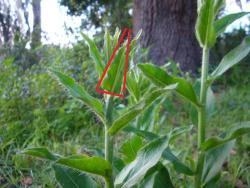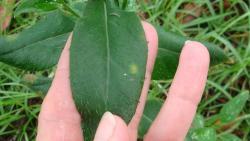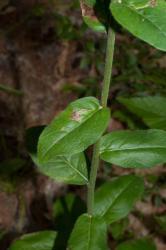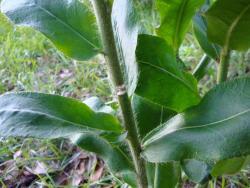First off this description fits:
FNA | Family List | FNA Vol. 19, 20 and 21 | Asteraceae | Hieracium
9. Hieracium gronovii Linnaeus, Sp. Pl. 2: 802. 1753.
Plants 30–45(–80) cm. Stems proximally piloso-hirsute (hairs 2–4+ mm), sometimes stellate-pubescent as well, distally stellate-pubescent, sometimes piloso-hirsute as well. Leaves: basal 0(–2+), cauline (3–)6–12+; blades elliptic or obovate to oblanceolate, 20–35(–90) × 10–40(–50) mm, lengths 2–4+ times widths, bases cuneate to rounded (sometimes ± clasping), margins entire, apices rounded to acute, abaxial faces piloso-hirsute (hairs 2–4 mm) and stellate-pubescent, adaxial piloso-hirsute. Heads (5–)25–50 in usually narrow, thyrsiform arrays (lengths of arrays usually 3–6+ times diams., sometimes shorter). Peduncles stellate-pubescent and stipitate-glandular. Calyculi: bractlets 8–12+. Involucres cylindric to campanulate, 7–10 mm. Phyllaries 12–15+, apices rounded to acute or acuminate, abaxial faces glabrous or stellate-pubescent, rarely stipitate-glandular as well. Florets 12–20+; corollas yellow, 8–9+ mm. Cypselae urceolate, 3.5–4.5+ mm; pappi of ca. 40+, stramineous bristles in 2+ series, ca. 5 mm.
Flowering (Mar–)Jul–Sep(–Oct). Openings in pine and pine-oak woods, bogs, sands; 30–600 m; Ont.; Ala., Ark., Conn., Del., D.C., Fla., Ga., Ill., Ind., Kans., Ky., La., Maine, Md., Mass., Mich., Minn., Miss., Mo., N.J., N.Y., N.C., Ohio, Okla., Pa., R.I., S.C., Tenn., Tex., Va., W.Va.; Mexico, Central America.
Source:
http://www.efloras.org/florata...
I dissected that botanical speak bit by bit.
If you read this:
Most plants referable to Hieracium are apomictic (reproducing from asexually produced seeds). Apomictic reproduction often results in perpetuation of morphologic variants at populational and regional levels. Temptation to name such variants as species has proven irresistible to some botanists; upward of 9,000 species names have been published in Hieracium. Circumscriptions of "species" in Hieracium seem to be more artificial than in most genera of composites. Under these circumstances, I feel it would be irresponsible to recognize any infraspecific taxa here. For the most part, the "species" recognized here are those that have been recognized in local and regional floras of the past 50 or so years. Accepted names and/or changes in synomymies for some species reflect changes suggested by J. H. Beaman (1990), A. Cronquist (1980), and E. G. Voss (1972–1996, vol. 3). I have maintained a traditional generic circumscription of Hieracium. Some other botanists exclude some species (including numbers 1–6 here) from Hieracium and treat them in Pilosella Hill, which differs from Hieracium in having stolons often produced, ribs of cypselae slightly projecting distally, and bristles of the pappi in one series. For Greenland, T. W. Böcher et al. (1968) reported 18 species of Hieracium: 16 said to be endemic to Greenland plus H. alpinum Linnaeus (known from Greenland and Eurasia) and H. groenlandicum Arvet-Touvet (= H. vulgatum Fries; known from Greenland and continental North America). Following H. J. Scoggan (1978–1979, part 4), I have placed 15 names of Greenland "endemics" as synonyms of other names. The type of the 16th "endemic," H. trigonophorum Oskarsson, is probably conspecific with that of H. alpinum. In my key and descriptions, "piloso-hirsute" refers to surfaces with scattered to crowded, tapered, whiplike, straight or curly, smooth to ± barbellate hairs mostly (0.5–)2–8(–15+) mm (sometimes called "setae"); "stellate-pubescent" refers to surfaces with scattered to crowded, ± dendritically branched (often called, but seldom truly, "stellate") hairs mostly 0.05–0.2+ mm (such surfaces are sometimes described as "floccose"); and "stipitate-glandular" refers to surfaces with scattered to crowded gland-tipped hairs mostly 0.2–0.8(–1.2+) mm. Surfaces of stems, leaves, peduncles, and phyllaries may be glabrous or may bear one, two, or all three of the types of hairs mentioned here; other induments are seldom encountered in hieraciums of the flora area. Given the complexity of the reproductive modes among the plants and the likelihood of misidentifications of vouchers, I have not included chromosome numbers for species. Sexual hieraciums are usually diploids (2n = 18) and the apomictic hieraciums are usually triploids (2n = 27).
Source:
http://www.efloras.org/florata...
The author explains his meaning, reasoning & definitions. This is the main page of Hieracium in eflora. Scroll down until you reach the blue portion where we get into the members of Hieracium. I went through each & every one of those to rule them out as possibilities..... or not. Firstly I threw out any that did not occur anywhere near the state of FL. For all of my research in this I checked numerous reliable resources & did not rely on someone's garden blog or some other questionable source of information. When I found members that occurred in Florida OR the neighboring states of GA & AL then I still considered it as a possibility here.
I will list the candidates and give a few reasons why it is ruled out as a possibility. I will not list the ones that do not occur anywhere near FL.
H. pilosella - mouse ear hawkweed ~~~ single inflorescences. NOT a candidate.
H. aurantica - orange hawkweed ~~~ basal rosette, each stem 1 or a dense cluster of flower heads NOT a candidate.
H. caespitosum - field hawkweed ~~~ does not occur in FL but does in GA so I considered it. Basal rosette, flat topped cluster of blooms, blooms too large to fit my plants NOT a candidate.
H. piloselloides - King Devil hawkweed ~~~ does not occur in FL but does in GA so I considered it. Flat headed panicle of blooms, buds completely wrong for my plants. NOT a candidate.
H. megacephalon - coastal plain hawkweed ~~~ Flat topped bloom array. NOT a candidate.
H. paniculatum - does not occur in FL but does in Ga so it was considered. Leaves all wrong, blooms incorrect to fit my plant. NOT a candidate.
H. scabrum - rough hawkweed ~~~ not a fit at all. NOT a candidate.
I am confident this is H. gronovii.
I am going to leave this thread open/unsolved for approximately 24 hours. I welcome your comments or arguments. I am willing to consider other suggestions. Otherwise, tomorrow night it goes to Kent for approval to the database as H. gronovii.





